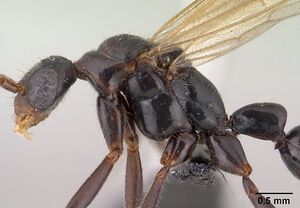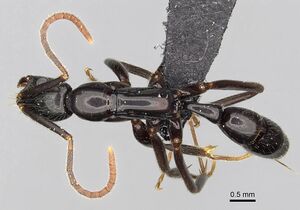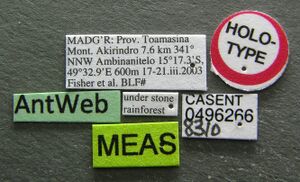Leptogenys johary
| Leptogenys johary | |
|---|---|

| |
| Scientific classification | |
| Kingdom: | Animalia |
| Phylum: | Arthropoda |
| Class: | Insecta |
| Order: | Hymenoptera |
| Family: | Formicidae |
| Subfamily: | Ponerinae |
| Tribe: | Ponerini |
| Genus: | Leptogenys |
| Species group: | attenuata |
| Species: | L. johary |
| Binomial name | |
| Leptogenys johary Rakotonirina & Fisher, 2014 | |
Individual workers of this species have been discovered foraging on the forest floor and in leaf litter. One nest was found under a rock.
Identification
A member of the attenuata species group. Rakotonirina and Fisher (2014) - Worker. Third antennal segment twice as long as second segment; eye large, maximum diameter about one-fourth the length of lateral cephalic margin; breaking line of side of head; in dorsal view, mesonotum broader than long and petiolar node remarkably elongate and strongly narrowed anteriorly.
Keys including this Species
Distribution
The northernmost range of L. johary in Madagascar is limited to the montane rainforest of the PN Masoala between 800–897 m, Amparihibe at 846 m, and the rainforest of Makira between 470–600 m. The southernmost distribution of this species is restricted to the RNI Betampona at an elevational range of 525–550 m and the FC Didy at 960 m.
Latitudinal Distribution Pattern
Latitudinal Range: -15.28833° to -15.28833°.
| North Temperate |
North Subtropical |
Tropical | South Subtropical |
South Temperate |
- Source: AntMaps
Distribution based on Regional Taxon Lists
Malagasy Region: Madagascar (type locality).
Distribution based on AntMaps
Distribution based on AntWeb specimens
Check data from AntWeb
Countries Occupied
| Number of countries occupied by this species based on AntWiki Regional Taxon Lists. In general, fewer countries occupied indicates a narrower range, while more countries indicates a more widespread species. |

|
Estimated Abundance
| Relative abundance based on number of AntMaps records per species (this species within the purple bar). Fewer records (to the left) indicates a less abundant/encountered species while more records (to the right) indicates more abundant/encountered species. |

|
Biology
|
Castes
Images from AntWeb
      
| |
| Male (alate). Specimen code casent0144593. Photographer Dimby Raharinjanahary, uploaded by California Academy of Sciences. | Owned by CAS, San Francisco, CA, USA. |
   
| |
| Worker. Specimen code casent0175314. Photographer Jean Claude Rakotonirina, uploaded by California Academy of Sciences. | Owned by CAS, San Francisco, CA, USA. |
   
| |
| Worker. Specimen code casent0175417. Photographer Jean Claude Rakotonirina, uploaded by California Academy of Sciences. | Owned by CAS, San Francisco, CA, USA. |
   
| |
| Holotype of Leptogenys johary. Worker. Specimen code casent0496266. Photographer Estella Ortega, uploaded by California Academy of Sciences. | Owned by CAS, San Francisco, CA, USA. |
Nomenclature
The following information is derived from Barry Bolton's Online Catalogue of the Ants of the World.
- johary. Leptogenys johary Rakotonirina & Fisher, 2014: 52, figs. 20A, 21A, 66, 79 (w.) MADAGASCAR.
Unless otherwise noted the text for the remainder of this section is reported from the publication that includes the original description.
Description
Worker
(8 specimens). HW: 0.95–0.98, HL: 1.38–1.47, CI: 66–69, SL: 1.37–1.48, SI: 143–153, PW: 0.74–0.83, WL: 2.21–2.33, PNH: 0.57–0.60, PNL: 0.73–0.80, PNW: 0.41–0.43, DNI: 51–57, LNI: 73–77.
Head elongate, very slightly diverging anteriorly, sides subparallel; posterior margin weakly concave. Mandible basal margin with blunt angle or preapical tooth. In full-face view, eye maximum diameter roughly one fourth the length of side of head; location breaking outline of side of head. Antennal scape long, about one third of its length surpassing posterior cephalic border; third antennal segment distinctly long, twice as long as the second. In dorsal view, mesonotum broader than long. Posterolateral margin of propodeum approximately at level of propodeal spiracle with toothlike lobe; propodeal spiracle rounded. With petiole in dorsal view, node elongate, twice as long as broad and greatly narrowed anteriorly. Mandible and clypeus smooth interspersed with scattered piligerous punctures; rest of body dorsum and propodeal declivity generally smooth and shining. Standing hairs arise from very small punctures, with longer, erect hairs on head and pronotum and much shorter hairs on rest of body dorsum. Body color brown to dark brown, with lighter appendages.
Type Material
Holotype worker: Madagascar, Toamasina, Montagne d'Akirindro 7.6 km 341° NNW Ambinanitelo, -15.28833, 49.54833, 600 m, rainforest, under stone, 17–21 Mar 2003 (Fisher, Griswold et al.) collection code: BLF08310, specimen code: CASENT0496266 (California Academy of Sciences). Paratypes: series of 8 workers, with same data as holotype but specimen coded: CASENT0496267, CASENT0496268, CASENT0196535, CASENT0247199, CASENT0247200, CASENT0247201, CASENT02472 02, CASENT0247273 (CASC, Parc Botanique et Zoologique de Tsimbazaza).
References
- Rakotonirina, J.C. & Fisher, B.L. 2014. Revision of the Malagasy ponerine ants of the genus Leptogenys Roger (Hymenoptera: Formicidae). Zootaxa 3836, 1-163.
References based on Global Ant Biodiversity Informatics
- Rakotonirina J. C., and B. L. Fisher. 2014. Revision of the Malagasy ponerine ants of the genus Leptogenys Roger (Hymenoptera: Formicidae). Zootaxa 3836 (1): 001163.

